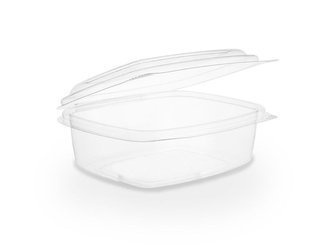Polylactide (PLA) - a bioplastic worth using!

Slogans such as "PLA" or "polylactide" are increasingly being bandied about in the context of eco-friendly ways to replace plastic. It is worth knowing that these two phrases mean exactly the same thing - poly lactic acid. For some time now, we can notice that products made of PLA bioplastic are appearing in stores, as well as catering establishments. Where does the popularity of products made from ecoplastic come from? Today we will talk about, among other things, the properties of polylactide and why it is worth using. We invite you to read more!
Polylactide - what is it?
Let's get straight to the point, that is, what polylactide (PLA) actually is. It is a biodegradable polymer, or plastic, which is formed by polymerization. It is produced from renewable raw materials - most often corn starch or sugar cane, which makes it natural in origin. In the simplest terms, we can say that polylactide is an eco-friendly plastic. And it is for this reason that it is increasingly being found in various places that are moving away from traditional plastic products.
Polylactide, or eco-friendly plastic
How is it possible for plastic to be environmentally friendly? Of course, it is impossible, unless we are talking about PLA, or bioplastic. After all, something that has a natural origin could not be harmful to nature. Products made from polylactide have this in common: if given the right conditions, they decompose very quickly into organic compounds. And this is the main reason why there is an increasing reliance on ecoplastics instead of plastic products, which will linger in the environment for thousands of years.
What are the benefits of making polylactide?
The fact that bioplastic is nature-friendly is determined not only by its significantly faster decomposition relative to traditional plastic, but by the fact that it decomposes into organic compounds rather than harmful microplastics. At this point, let's lean for a moment on the production of PLA itself. Making polylactide requires the consumption of much smaller amounts of fossil fuels than PET or PP. What's more, the raw material from which PLA is made is 100% renewable.
Ecoplastic is made from plants, which as we know - produce oxygen, and thus - absorb carbon dioxide. This is another benefit for our environment and has an impact on reducing the effect of global warming, among other things.
Certificates confirming the compostability of bioplastic products
Most often we can meet two certificates confirming the compostability of PLA products - OK Compost Industrial, which means that the product is fully compostable in industrial conditions, or OK Compost Home, which assures us that the product will decompose even in a home composter. We can use bags with such a certificate, for example, to collect organic waste, so that we can later dispose of it with the bag in a place intended for this purpose.
Polylactide - properties of ecoplastic
What can be said about the properties of PLA? First of all, bioplastic is characterized by the fact that it is fully biodegradable, as we mentioned in an earlier paragraph. This property has been confirmed by the COBRO Packaging Research Institute, among others. This is the biggest advantage of this plastic, but it is not the only reason for using PLA in everyday life.
What else can we say about polylactide? First of all, the fact that the ecoplastic has excellent organoleptic properties - starting with the smell, going through the texture and ending with the appearance. Thanks to these characteristics, bioplastic is completely neutral in contact with food, which is why it is now so readily used in many food service establishments.
Where does bioplastic excel?
Traditional polylactide melts already at 40-50 degrees Celsius, which is why it is not recommended for hot food or beverages, but also for the mentioned applications we have a great solution - C-PLA, which is a bioplastic with increased resistance to high temperatures (even up to 90 degrees Celsius). It will perform well even with the hottest meals.
PLA is therefore the perfect solution for catering, as it combines all the advantages of traditional plastic, while not taking over its biggest drawback - environmental pollution.
Polylactide - application of bioplastic in gastronomy
Ecoplastic, as we have already mentioned, is readily used in catering outlets of various kinds. An increasing number of restaurants, pubs or food trucks are offering their customers products made of PLA, which is backed by the sometimes already mentioned biodegradability. What is currently produced from PLA for food service?
Cups made of bioplastic
Disposable and lightweight cornmeal cups are some of the most common products that can be found on store shelves, as well as in food service establishments. They are great for serving cold drinks, as well as a substitute for ice cream and dessert bowls.
PLA glasses
We can also increasingly meet disposable, biodegradable PLA alcohol glasses. They are a great substitute for plastic glasses or glass ones. They can be used, for example, during outdoor events.
Eco-friendly sauce containers made of polylactide
Ecological containers for sauces made of bioplastic can most often be found in pizzerias and food trucks, where additions to dishes in the form of delicious dips are served. The small containers allow you to freely use the sauce, which will in no way change its taste after contact with the eco-plastic.
PLA eco cutlery
What would a restaurant, pub, pub or bar be without a cutlery set? Until recently, disposable plastic knives, forks and spoons reigned supreme in such establishments. Today, fortunately, they are moving away from this, replacing these products with cutlery made of polylactide, which is most often made of cornstarch. Thanks to their properties, they are suitable for eating even the hottest food (they can withstand temperatures up to 90°C). Disposable PLA cutlery is characterized by durability, as well as lightness, which provides comfort while eating.
Polylactide natural packaging
Nowadays, taking food to go is a very popular solution. For this, the use of special containers is required, which will allow the free transport of meals. An excellent example of such products are biodegradable PLA packaging, into which salads, sandwiches, desserts or snacks, among others, are most often packed.
Nets and commercials made of bioplastic
An excellent alternative to plastic, there are also fully compostable commercial bags made of bioplastic. They are in no way inferior to classic, and therefore harmful, plastic commercials, except that, unlike them, they will even decompose in a backyard composter just like our OK COMPOST HOME certified bags.
Curious about what products made of polylactide actually look like? Visit our organic wholesaler SlowPack - we have a wide range of cutlery, organic packaging, cups and other accessories made from cornmeal.
Recommended



